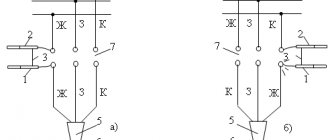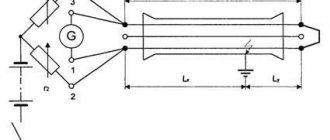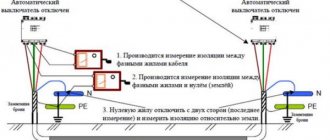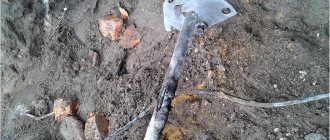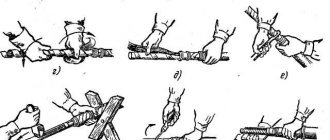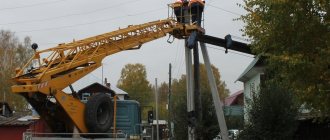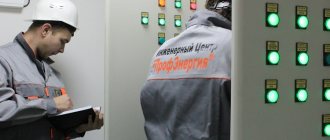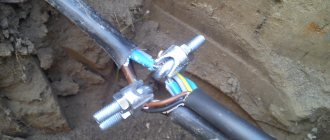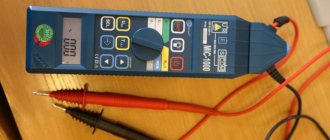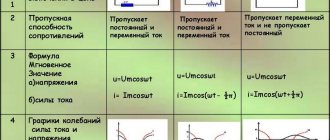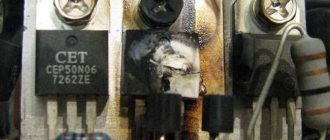Why do you need cable network maintenance?
Constant technical supervision of the condition of cable lines and prevention of damage is a necessary condition for maintaining their functionality. During operation, damage to the integrity of the cable occurs - broken wires, decreased insulation resistance, and failure of the tightness of the protective coating. Such breakdowns lead to operational downtime and financial losses. Cable network maintenance is a thorough supervision of the condition of ground, underground and overhead cable lines, testing, checking cable loads, and performing the necessary repair work.
When performing CL monitoring, it is important that:
- the cables were clean;
- foreign objects did not interfere with repair work;
- There were no holes, landslides or potholes on the surface of the earth that could damage the cable.
It is especially important to monitor the condition of the cable line during excavation work nearby - the permissible distance for placing equipment is no closer than one meter. If it is necessary to work closer than this distance, safety regulations only allow the use of a shovel.
| Service | Price |
| Maintenance of transformer substation TP-10/0.4 kV (together with an overhead or cable power line of 10 kV). | from 11,000 rub. monthly without VAT 20%. |
| Maintenance of electrical installations up to 1000V (shops, offices, industrial premises and free-standing buildings). | from 9000 rub. monthly without VAT 20%. |
| Comprehensive maintenance of electrical installations: transformer substation TP-10/0.4 kV (together with overhead or cable power lines 6/10 kV) and electrical installations up to 1000V. | from 13,000 rub. monthly without VAT 20%. |
The procedure for repair and restoration work
"LABSIZ" carries out repairs of high-voltage cables and low-voltage lines in the following order:
- A team of craftsmen arrives at the scene. Electricians get acquainted with reports on previous activities and prepare equipment.
- As part of a simple restoration, the company restores the integrity of the damaged dielectric shell, repairs armored areas, end seals, and performs other routine activities.
- As part of complex restoration, LABSIZ dismantles damaged sections of communications and replaces them with new ones, re-cuts end funnels, and reinstalls cable couplings.
The cost of repairing a 10 kV power cable depends on the total volume, complexity and urgency of the work. After completion, the company draws up reports for submission to the supervisory authorities.
Current and major repairs
Maintenance of overhead (OHL) and cable lines can be routine and scheduled preventative. During such activities the following are carried out:
- supervision of the route, structures and operation of equipment - automation, remote control and alarm devices;
- taking preventive measures;
- checking the electrical parameters of the cable;
- eliminating detected problems;
- maintaining a stock of consumables, cables and fittings - so that in case of damage to the line, the breakdown can be promptly repaired;
- maintaining in proper condition vehicles, equipment, tools, special clothing, etc. - everything that is needed for the implementation of scheduled maintenance and repair work;
- elimination of damage and emergency situations;
- taking measures to protect the cable from damage;
- preventing erosion and landslides along the line;
- installation of warning signs in areas where construction work is expected to take place and in areas where the cable is close to various structures;
- preparation of technical documentation.
Direct current measures the insulation resistance of automation, communications, telemechanics and the cable cores themselves. The variable is used to determine the attenuation of circuits, characteristic impedance and other operating parameters. Cable circuits are tested using direct current in spring and autumn. Alternating current is used for measurements once every 3 years, telephone cables are checked with it once every 5 years. To determine values in station automation and telemechanics cable networks, insulation is monitored through grounding detectors.
Overhaul of the route is necessary in case of serious damage to the power cables, leading to a break, a decrease in insulation resistance or a leak. Engineers are faced with the task of finding and repairing the gap - to solve this they use cable detectors and halide leak detectors. Electrical measurements are used to determine local damage—short circuit or broken wires. They are also used to determine the condition of cable circuits. Maintenance of linear cable structures includes inspection of boxes, couplings, racks, cable boxes, supports, sewers and guy wires.
How repairs are carried out
Depending on the characteristics of the damage that has occurred, it can be simple or complex. The timing of the work and the prices for repairing a 10 kV cable or other voltage depend on them.
Operations such as restoration of the insulating shell, repair of armor and end seals, and some other work performed by one team within one shift are considered simple.
If, in order to restore the power supply, it is necessary to dismantle large (several tens of meters in length) sections of cable to replace it, the repair is considered complex. Difficulties in its implementation are associated with the presence of turns and intersections with utilities and roads on the cable route, and the need to warm up the soil in the cold season. Complex repairs often require two or more teams, often requiring the use of earthmoving and other equipment.
Prices for electrical measuring work "PROFENERGIYA":
| Services | Unit | Cost per unit of measurement, rub. | |
| Electrical installations over 1000 V to 35 kV | |||
| Checking compliance of the installed electrical installation with the requirements of the design documentation | inspection | From 3000 | |
| Checking the presence of a circuit between grounding conductors and grounded elements | dot | From 25 | |
| Testing of fuses, fuse-disconnectors for voltages over 1 kV. | PC. | From 490 | |
| Testing of power cable lines with voltage up to 20 kV. | PC. | From 9500 | |
| Testing of power cable lines with cross-linked polyethylene insulation with voltage up to 35 kV. | Trial | From 8000 | |
| Testing of power transformers, autotransformers, oil reactors and grounding arc arresters with rated voltage up to 35 kV. power up to 63000 kVA | PC. | From 15000 | |
| Testing of switchgear and switchgear. | PC. | From 14900 | |
| Testing of oil, air, vacuum circuit breakers, disconnectors, short circuiters and separators. | PC. | From 1400 | |
| Testing of complete busbars (busbars). | PC. | From 2500 | |
| Testing of busbars and connecting busbars. | PC. | From 2500 | |
| Testing of valve, tubular arresters and surge suppressors. | PC. | From 4000 | |
| Testing of bushings and bushings. | PC. | From 5000 | |
| Testing of suspension and support insulators | PC. | From 6000 | |
| Testing of dry current-limiting reactors. trial | Trial | From 5000 | |
| Inspection of cells (checking and adjusting relay equipment) | Complex | From 15000 | |
| Testing of AC electric motors with rated voltage up to 20 kV. | Complex | From 20000 | |
| Checking switchgear and their connections | Complex | From 10000 | |
| Testing of electrical equipment with increased voltage 1 kV industrial frequency | Measurement | From 500 | |
| Testing of synchronous generators and compensators | Measurement | From 8000 | |
| Testing of measuring current transformers | Trial | From 5000 | |
| Testing of voltage transformers | Trial | From 3500 | |
| Testing of dry current-limiting reactors. | Trial | From 4500 | |
| Capacitor testing. | PC. | From 1800 | |
| Transformer oil testing | Sample (1 liter) | From 8000 | |
| Testing power lines with voltages above 1 kV | Complex | From 20000 | |
| Comprehensive testing | |||
| Carrying out electrical measuring work with the preparation of a technical report from 1000V to 35kV | |||
| Acceptance tests. | Complex of works | From 20000 | |
| Performance tests. | Complex of works | From 20000 | |
| For certification purposes | Complex of works | From 8000 | |
| Engineer visit | Departure | For free | |
| Drawing up single-line diagrams | PC. | From 2000 | |
| Drawing up a grounding device passport | PC. | From 10000 | |
Professional approach
"LABSIZ" carries out repair and restoration work in compliance with GOSTs, PUE, RD, and other regulatory documents. The company is certified and has all the necessary permits and approvals. Strictly monitors compliance with safety regulations. Repairs to cable sheaths made of cross-linked polyethylene and other dielectric materials are carried out using high-precision equipment and modern non-destructive technologies. LABSIZ has its own mobile electrical laboratory at its disposal. The company's specialists will reach the most inaccessible areas of the enterprise - and restore the operation of the line faster than could have been planned!
Frequency of technical inspections
Maintenance and repair of cable lines depends on various factors - from the materials used to the place where they are laid. If cables are located in areas with a high risk of damage, they are inspected more often. For cable lines with voltages up to 10 kV, depending on the location of installation, the PTE rules regulate the following inspection frequency:
- in wells - once every 6 months;
- in collectors, trenches - once 4 months;
- maintenance of cable power lines at voltages up to 1000 W (terminal couplings) - once every 12 months, more than 1000 W - once every 6 months;
- in transformers, substations - distribution points, end couplings are inspected together with other equipment.
During floods and difficult weather conditions, inspections are performed out of turn. Carrying out earthworks or excavations near highways is possible only with the written permission of the organization servicing them. After completing excavations near the route, engineers conduct an extraordinary inspection. The frequency of testing underground cable lines that have worked flawlessly for 5 years is determined individually by the person responsible for electrical equipment, but cannot be less than once every three years.
Cable maintenance and repair
298. All work with the cable (repair, connection, high voltage testing, connection, disconnection) must be carried out by specially trained electrical personnel in accordance with the requirements of the manufacturer and these Instructions (Appendix 3).
299. Work on termination, repair and connection of cables in quarries is allowed only after disconnecting it from the connection point and discharging it from residual charges by applying portable grounding.
300. Inspection of cables supplying electrical installations of mobile electrical consumers is carried out:
technological personnel - every shift;
electrical personnel - monthly.
Trunk cable lines must be inspected by electrical personnel at least once a month.
301. During a shift-by-shift inspection of the cable, the following is checked: the correctness of its laying along the route, the absence of rips and cracks to the depth of the sheath, punctures and cuts in the shunting area (20 m from the input device), crushing from collisions with vehicles or falling blocks of rock and other mechanical damage to the outer hose sheath.
The results of the shift inspection are recorded in the operational journal.
302. The scope of the monthly inspection includes: work provided for by the shift inspection, and inspection of the cable end seals, which checks for the presence of ozone cracks on the insulation surface of the current-carrying conductors, and the degree of contamination of the insulating gaps of the end seals.
The results of the monthly inspection are recorded in the operational journal.
303. Before putting the cable into operation, end seals must be made at its ends, including sealing the hose, sealing the insulation of the main cores, pressing (soldering) the tips or preparing the ends of the cores for special clamps.
304. The termination of the main conductors should prevent: overlaps at voltages not less than the rated linear voltage, as well as with possible internal overvoltages;
significant reduction in insulation levels;
corona discharges on each core and between the cores at a voltage not less than the rated linear voltage;
possibility of moisture and dust penetration into the cable.
When performing termination using elastomeric end couplings, it is permissible not to terminate the end of the sheath if the input device prevents water from entering the cable.
305. The length of the cores in the cable termination is determined by the design, dimensions of the electrical equipment input device, the location of the connecting pins in it and must be at least 350 mm.
The bending radius of insulated conductors in input devices should be as maximum as possible, especially at the border of the electrically conductive screen with the insulation.
306. Fastening the cable in the input device must prevent the insulated parts of the current-carrying conductors from touching each other, the live and grounded parts.
307. At an enterprise that has in constant operation more than 1000 m of flexible rubber cables for voltages above 1000 V or more than 2000 m of flexible rubber cables for voltages up to 1000 V, it is recommended to organize a cable repair service.
308. Vulcanizing devices must be factory-made and meet the requirements for the safe performance of work by operating personnel.
309. Before putting into operation, a cable with completed terminations, both new and repaired, must be tested with increased voltage.
The insulation of new and repaired cables with terminations for voltages up to 1000 V must withstand a test voltage of at least 2500 V for 1 minute.
The insulation of new cables for a voltage of 6 kV with end seals and cables in operation, as well as repaired ones, must withstand a test voltage of at least 12 kV of rectified current for 5 minutes.
310. Periodic tests of cables are carried out at least once a year. During periodic tests, the integrity of the cable cores and shielding braid is checked. If there are breaks, the cable is not allowed to be used.
The results of insulation tests and the condition of the cable structural elements must be recorded in a log.
311. Each cable in service must have a securely attached tag with a number on one of the cut ends. Data on the condition of the new cable and the results of its subsequent repairs and tests are entered into the log; a note is made in the same log about the cable being removed from service (decommissioned).
The form of the logbook for accounting, repair and testing of cables is determined by the person responsible for the electrical equipment of the organization.
312. When preparing a high-voltage cable for 6 - 10 kV for testing, it is necessary:
disconnect the cable from the network, disconnect the cable from the connection point and discharge;
install warning signs “Stop!”, “Voltage!” and set up control posts along the cable route;
inspect the hose sheath to identify external damage and subsequent repairs;
carefully inspect the end seals to control the cleanliness of the surface of the power cores, and if cracks are detected, make repairs;
check the integrity of the power and grounding conductors, shielding braids, and then connect the grounding conductor to the shielding braids at both ends of the cable;
measure the insulation resistance of the power conductors with a megohmmeter for a voltage of 2500 V; after each measurement, it is necessary to discharge the conductor to ground.
313. The test voltage is applied in turn to each cable core. At the time of testing, two other conductors, screens and a grounding conductor are connected to each other and grounded, the rectified voltage is increased smoothly at a speed of no more than 0.5 kV/s. When the test voltage is reached, the magnitude of the leakage current should be constantly monitored. When the leakage current increases or impulse shocks appear, it is allowed to increase the test voltage by 0.5 - 2.0 kV/s in order to break down the defective section of the insulation.
314. If, when testing the cable, no insulation breakdown occurs, then the tested cable is considered suitable for use. The microammeter readings are taken at the last minute of the test.
315. The test voltage is removed smoothly. After disconnecting the testing apparatus from the network, the tested conductor is discharged using a grounding rod.
316. Testing of flexible high-voltage cables for 6 - 10 kV with increased voltage is carried out by specially trained persons, one of whom must have a qualification group of at least IV.
When periodically testing cables for voltages up to 1000 V using a megger, work can be performed by one trained person with qualification group III.
317. Determining the location of a fault in a cable by any of the methods (induction, acoustic, capacitive or loop method) is permitted only after disconnecting the cable from the power supply and discharging residual electrical charges to the ground.
XV. LIGHTING
318. To power lighting networks, as well as lighting devices on mobile machines, mechanisms and units, an electrical system with an insulated neutral at a line voltage, usually 220 V, must be used.
319. When using special lighting installations for illuminating dumps and roads outside the quarry, as well as stationary transfer points, when powered from separate transformer substations in a network with a grounded neutral, the use of voltages above 220 V is permitted.
320. It is allowed to use networks with a solidly grounded neutral with a voltage of up to 1 kV to supply power from individual transformers for lighting installations of stationary transfer points and dumps, entry (exit) trenches, special lighting installations and signaling, centralization and interlocking networks (SCB). In this case, the grounding device of these installations should not have a galvanic connection with the isolated neutral.
321. Maintenance of lighting installations must be carried out with the voltage removed.
Replacement of lamps and fixtures, repair of lighting network elements (replacement of hooks, pins and insulators, re-tensioning of wires, etc.) located on the contact network supports must be carried out in accordance with the work permit.
Technical inspections and repairs of lighting installations must be carried out, as a rule, within the time limits regulated for the package transformer substation.
322. Maintenance of lighting installations with starting devices is carried out according to a work permit by at least two persons, one of whom must have a qualification group of at least IV, and the other - at least III.
323. Starting devices for lighting installations must have on the front side of the door indications about the voltage level, the danger of electric shock, an inventory number, and on the inside of the door - a circuit diagram.
324. The outdoor area should be illuminated by lamps and spotlights installed, as a rule, on mobile or stationary supports (masts). They can be metal, reinforced concrete or wood.
325. On stationary supports of a direct current contact network with voltage up to 1650 V inclusive, it is allowed to hang electric lighting wires and lamps only for lighting railway transport facilities. In this case, the following conditions must be met:
the wires of the lighting lines are suspended above the contact wire on the opposite side of the support;
the distance from the contact wire to the lighting wires must be at least 1.5 m;
lighting network insulators are selected according to the contact network voltage.
326. Repair of the lighting network (replacement of hooks, pins and insulators, re-tensioning of wires, etc.) must be carried out with the voltage removed from both the contact and lighting networks.
327. Suspension of electric lighting wires and lamps on mobile supports of the contact network is not allowed.
328. It is prohibited to use light sources without protective lighting fixtures.
329. Lighting of work areas of mobile installations should be done with floodlights and lamps installed on the machines themselves.
330. To power local stationary lighting fixtures with incandescent lamps, the following voltage must be used:
in rooms without increased danger - no higher than 220 V;
in rooms with increased danger and especially dangerous - no higher than 42 V.
331. Voltage up to 220 V inclusive is allowed for lamps of special design:
being an integral part of emergency lighting, powered by an independent current source;
installed in areas with increased danger (but not particularly dangerous).
332. Metal fittings of lamps with voltages above 42 V must be reliably grounded.
333. In rooms with increased danger and especially dangerous when installing lamps with incandescent lamps above the floor below 2.5 m, it is necessary to use lamps of a special design or use a voltage not exceeding 42 V. This requirement does not apply to lamps served from cranes or from platforms, visited only by qualified personnel.
334. If lamps are located in workshops at a high altitude, they can be serviced using cranes, and the work must be performed by electrical personnel wearing dielectric gloves and in the presence of a second person.
335. Lamps with fluorescent lamps with a voltage of 127 - 220 V may be used for local lighting provided that their live parts are not accessible to accidental touches. They should be installed at least 2.5 m.
336. The use of open (unprotected) fluorescent lamps in industrial premises is not permitted, with the exception of premises not intended for long-term occupancy of people.
In damp, especially damp, hot and chemically active environments, the use of fluorescent lamps for local lighting is allowed only in specially designed fittings.
337. Power supply for luminaires with a voltage of 42 V and below must be supplied from transformers with electrically separate primary and secondary voltage windings.
338. In especially dangerous premises, as well as under particularly unfavorable conditions, when the danger of electric shock is aggravated by the cramped, inconvenient position of the worker in contact with large metal, well-grounded surfaces (work in boilers, tanks, tanks, etc.), for For power supply of hand-held and portable lamps, a voltage of no higher than 12 V must be used.
339. When preparing solutions of flotation reagents for local lighting, it is allowed to use only portable lamps with a voltage not exceeding 12 V.
340. Sockets and plugs 12 - 36 V must be different and must not fit sockets and plugs 127 - 220 V.
Connection of portable lamps with a voltage of 12 - 36 V must be carried out using flexible hose wires.
298. All work with the cable (repair, connection, high voltage testing, connection, disconnection) must be carried out by specially trained electrical personnel in accordance with the requirements of the manufacturer and these Instructions (Appendix 3).
299. Work on termination, repair and connection of cables in quarries is allowed only after disconnecting it from the connection point and discharging it from residual charges by applying portable grounding.
300. Inspection of cables supplying electrical installations of mobile electrical consumers is carried out:
technological personnel - every shift;
electrical personnel - monthly.
Trunk cable lines must be inspected by electrical personnel at least once a month.
301. During a shift-by-shift inspection of the cable, the following is checked: the correctness of its laying along the route, the absence of rips and cracks to the depth of the sheath, punctures and cuts in the shunting area (20 m from the input device), crushing from collisions with vehicles or falling blocks of rock and other mechanical damage to the outer hose sheath.
The results of the shift inspection are recorded in the operational journal.
302. The scope of the monthly inspection includes: work provided for by the shift inspection, and inspection of the cable end seals, which checks for the presence of ozone cracks on the insulation surface of the current-carrying conductors, and the degree of contamination of the insulating gaps of the end seals.
The results of the monthly inspection are recorded in the operational journal.
303. Before putting the cable into operation, end seals must be made at its ends, including sealing the hose, sealing the insulation of the main cores, pressing (soldering) the tips or preparing the ends of the cores for special clamps.
304. The termination of the main conductors should prevent: overlaps at voltages not less than the rated linear voltage, as well as with possible internal overvoltages;
significant reduction in insulation levels;
corona discharges on each core and between the cores at a voltage not less than the rated linear voltage;
possibility of moisture and dust penetration into the cable.
When performing termination using elastomeric end couplings, it is permissible not to terminate the end of the sheath if the input device prevents water from entering the cable.
305. The length of the cores in the cable termination is determined by the design, dimensions of the electrical equipment input device, the location of the connecting pins in it and must be at least 350 mm.
The bending radius of insulated conductors in input devices should be as maximum as possible, especially at the border of the electrically conductive screen with the insulation.
306. Fastening the cable in the input device must prevent the insulated parts of the current-carrying conductors from touching each other, the live and grounded parts.
307. At an enterprise that has in constant operation more than 1000 m of flexible rubber cables for voltages above 1000 V or more than 2000 m of flexible rubber cables for voltages up to 1000 V, it is recommended to organize a cable repair service.
308. Vulcanizing devices must be factory-made and meet the requirements for the safe performance of work by operating personnel.
309. Before putting into operation, a cable with completed terminations, both new and repaired, must be tested with increased voltage.
The insulation of new and repaired cables with terminations for voltages up to 1000 V must withstand a test voltage of at least 2500 V for 1 minute.
The insulation of new cables for a voltage of 6 kV with end seals and cables in operation, as well as repaired ones, must withstand a test voltage of at least 12 kV of rectified current for 5 minutes.
310. Periodic tests of cables are carried out at least once a year. During periodic tests, the integrity of the cable cores and shielding braid is checked. If there are breaks, the cable is not allowed to be used.
The results of insulation tests and the condition of the cable structural elements must be recorded in a log.
311. Each cable in service must have a securely attached tag with a number on one of the cut ends. Data on the condition of the new cable and the results of its subsequent repairs and tests are entered into the log; a note is made in the same log about the cable being removed from service (decommissioned).
The form of the logbook for accounting, repair and testing of cables is determined by the person responsible for the electrical equipment of the organization.
312. When preparing a high-voltage cable for 6 - 10 kV for testing, it is necessary:
disconnect the cable from the network, disconnect the cable from the connection point and discharge;
install warning signs “Stop!”, “Voltage!” and set up control posts along the cable route;
inspect the hose sheath to identify external damage and subsequent repairs;
carefully inspect the end seals to control the cleanliness of the surface of the power cores, and if cracks are detected, make repairs;
check the integrity of the power and grounding conductors, shielding braids, and then connect the grounding conductor to the shielding braids at both ends of the cable;
measure the insulation resistance of the power conductors with a megohmmeter for a voltage of 2500 V; after each measurement, it is necessary to discharge the conductor to ground.
313. The test voltage is applied in turn to each cable core. At the time of testing, two other conductors, screens and a grounding conductor are connected to each other and grounded, the rectified voltage is increased smoothly at a speed of no more than 0.5 kV/s. When the test voltage is reached, the magnitude of the leakage current should be constantly monitored. When the leakage current increases or impulse shocks appear, it is allowed to increase the test voltage by 0.5 - 2.0 kV/s in order to break down the defective section of the insulation.
314. If, when testing the cable, no insulation breakdown occurs, then the tested cable is considered suitable for use. The microammeter readings are taken at the last minute of the test.
315. The test voltage is removed smoothly. After disconnecting the testing apparatus from the network, the tested conductor is discharged using a grounding rod.
316. Testing of flexible high-voltage cables for 6 - 10 kV with increased voltage is carried out by specially trained persons, one of whom must have a qualification group of at least IV.
When periodically testing cables for voltages up to 1000 V using a megger, work can be performed by one trained person with qualification group III.
317. Determining the location of a fault in a cable by any of the methods (induction, acoustic, capacitive or loop method) is permitted only after disconnecting the cable from the power supply and discharging residual electrical charges to the ground.
XV. LIGHTING
318. To power lighting networks, as well as lighting devices on mobile machines, mechanisms and units, an electrical system with an insulated neutral at a line voltage, usually 220 V, must be used.
319. When using special lighting installations for illuminating dumps and roads outside the quarry, as well as stationary transfer points, when powered from separate transformer substations in a network with a grounded neutral, the use of voltages above 220 V is permitted.
320. It is allowed to use networks with a solidly grounded neutral with a voltage of up to 1 kV to supply power from individual transformers for lighting installations of stationary transfer points and dumps, entry (exit) trenches, special lighting installations and signaling, centralization and interlocking networks (SCB). In this case, the grounding device of these installations should not have a galvanic connection with the isolated neutral.
321. Maintenance of lighting installations must be carried out with the voltage removed.
Replacement of lamps and fixtures, repair of lighting network elements (replacement of hooks, pins and insulators, re-tensioning of wires, etc.) located on the contact network supports must be carried out in accordance with the work permit.
Technical inspections and repairs of lighting installations must be carried out, as a rule, within the time limits regulated for the package transformer substation.
322. Maintenance of lighting installations with starting devices is carried out according to a work permit by at least two persons, one of whom must have a qualification group of at least IV, and the other - at least III.
323. Starting devices for lighting installations must have on the front side of the door indications about the voltage level, the danger of electric shock, an inventory number, and on the inside of the door - a circuit diagram.
324. The outdoor area should be illuminated by lamps and spotlights installed, as a rule, on mobile or stationary supports (masts). They can be metal, reinforced concrete or wood.
325. On stationary supports of a direct current contact network with voltage up to 1650 V inclusive, it is allowed to hang electric lighting wires and lamps only for lighting railway transport facilities. In this case, the following conditions must be met:
the wires of the lighting lines are suspended above the contact wire on the opposite side of the support;
the distance from the contact wire to the lighting wires must be at least 1.5 m;
lighting network insulators are selected according to the contact network voltage.
326. Repair of the lighting network (replacement of hooks, pins and insulators, re-tensioning of wires, etc.) must be carried out with the voltage removed from both the contact and lighting networks.
327. Suspension of electric lighting wires and lamps on mobile supports of the contact network is not allowed.
328. It is prohibited to use light sources without protective lighting fixtures.
329. Lighting of work areas of mobile installations should be done with floodlights and lamps installed on the machines themselves.
330. To power local stationary lighting fixtures with incandescent lamps, the following voltage must be used:
in rooms without increased danger - no higher than 220 V;
in rooms with increased danger and especially dangerous - no higher than 42 V.
331. Voltage up to 220 V inclusive is allowed for lamps of special design:
being an integral part of emergency lighting, powered by an independent current source;
installed in areas with increased danger (but not particularly dangerous).
332. Metal fittings of lamps with voltages above 42 V must be reliably grounded.
333. In rooms with increased danger and especially dangerous when installing lamps with incandescent lamps above the floor below 2.5 m, it is necessary to use lamps of a special design or use a voltage not exceeding 42 V. This requirement does not apply to lamps served from cranes or from platforms, visited only by qualified personnel.
334. If lamps are located in workshops at a high altitude, they can be serviced using cranes, and the work must be performed by electrical personnel wearing dielectric gloves and in the presence of a second person.
335. Lamps with fluorescent lamps with a voltage of 127 - 220 V may be used for local lighting provided that their live parts are not accessible to accidental touches. They should be installed at least 2.5 m.
336. The use of open (unprotected) fluorescent lamps in industrial premises is not permitted, with the exception of premises not intended for long-term occupancy of people.
In damp, especially damp, hot and chemically active environments, the use of fluorescent lamps for local lighting is allowed only in specially designed fittings.
337. Power supply for luminaires with a voltage of 42 V and below must be supplied from transformers with electrically separate primary and secondary voltage windings.
338. In especially dangerous premises, as well as under particularly unfavorable conditions, when the danger of electric shock is aggravated by the cramped, inconvenient position of the worker in contact with large metal, well-grounded surfaces (work in boilers, tanks, tanks, etc.), for For power supply of hand-held and portable lamps, a voltage of no higher than 12 V must be used.
339. When preparing solutions of flotation reagents for local lighting, it is allowed to use only portable lamps with a voltage not exceeding 12 V.
340. Sockets and plugs 12 - 36 V must be different and must not fit sockets and plugs 127 - 220 V.
Connection of portable lamps with a voltage of 12 - 36 V must be carried out using flexible hose wires.
Causes and types of cable damage
Engineering specialists who perform maintenance and repair of cable lines identify the following common causes of insulation damage:
- manufacturing defects - cracks, through holes, burrs, mismatch of paper tapes, etc.;
- poor-quality soldering of connections, coupling necks;
- defects resulting from the laying of routes - breakdowns, dents, kinks, bends, congestion;
- corrosion that appears as a result of contact with the soil composition or under the influence of stray currents;
- insulation breaks during wiring or excavation;
- natural wear and tear resulting from overheating or aging of the insulation.
The causes of a short circuit are most often overheating of the conductors or natural displacement of the soil, ending with their breakage. If the cable cores overheat above permissible limits, the technician will do everything possible to eliminate the overheating. To reduce the temperature of current-carrying conductors, different methods are used:
- reduce the load;
- make inserts with a large cross-section;
- increase the flow of ventilated air in tunnels;
- increase the distance between cables.
In industry, when a section of a route fails, operating equipment is transferred to other lines. Such a decision can lead to a critical increase in load. For cables with voltages up to 10 kV, the upper limit of the permissible limit is 30% - the overload should not exceed 5 days (if the cable experienced a load of up to 80% during normal operation). It is prohibited to overload cables with a voltage of 20-35 kV - any overload can lead to an accident. All work carried out to determine the location of damage is divided into two types: relative and absolute. The first method determines the distance from the measurement point to the place of voltage loss, and the second is necessary in order to find the location of future excavation.
To determine the location of the damage, the center's engineers use different measurement methods. Maintenance of 10 kV cable lines includes measuring the insulation resistance of each core - between pairs and in relation to ground. Measurements are carried out using a megohmmeter - they can restore the integrity of the cable by installing a short circuit at one end. In high voltage cables, each core is tested (with and without grounding). To do this, they use direct current generated by an AII-70 type installation, slowly raising the voltage to the desired level. In case of multiple ruptures, IKL-4 and IKL-5 installations are used.
| Cable lines 10kV | Inspections 1. Inspection of the cable line route (within the scope of inspection) 2. Check for markings on cable lines. 3. Inspection of cable joints (within the scope of inspection). 4. Inspect the cable line insulation for damage (within the scope of inspection). 5. Checking the integrity and phasing of the cable cores. 6. Checking the tightness of passages. Checking cable fastenings, checking cable sheath grounding connections |
| Tests 1. Checking the integrity and phasing of the cable cores. PUE chapter 1.8.40., clause 1 2. Insulation resistance measurement. PUE chapter 1.8.40., clause 2 3. High voltage test. PUE chapter 1.8.40., clause 3 |
When is cable line repair needed?
Electrical networks stop functioning for various reasons. Most often, the main cause of the malfunction is damage to the insulation, because even with deep cable laying, mechanical and dynamic loads cannot be excluded. Power lines may operate less efficiently or fail altogether for other reasons:
- Loose contact or disruption of insulation integrity in vulnerable places: on end or connecting couplings.
- Illiterate installation.
- Subsidence or displacement of soil.
- Severe overheating.
- Inconsistency between the power supply of the existing cable line.
Considering the high probability of untimely failure or serious loss of power in the electrical network, EnergoServiceGarant specialists recommend regularly diagnosing cable lines, as well as updating outdated equipment.
Advantages of contacting ProfEnergia
Maintenance and repair of cable lines must be carried out by engineers who have the necessary knowledge, experience, and also have the appropriate permits. Engineering has a license from RosTechNadzor No. 5749, so it can guarantee the quality of the work performed, the accuracy of measurements and confirm the qualifications of the personnel. The cost of the company’s services is fully compensated by trouble-free operation, lack of downtime and a guarantee of safety for the customer’s employees.
Advantages of working with ProfEnergia:
- accuracy of measurement results - all equipment has metrological verification certificates;
- free visit of a specialist to the site and preparation of an estimate;
- prices in the price list are 25% lower than those of other Moscow companies;
- quality assurance - drawing up protocols and reports of work performed;
- execution of the application within 1-3 days.
You can order a calculation of the cost of work by filling out a request for a specialist to visit you. Clients receive free diagnostics of the condition of cable networks, expert advice, and a quick estimate. Our center is ready to take care of maintaining your tracks in good condition and also guarantees their functionality.
Devices
Meter of resistance, humidity and degree of aging of insulation MIC-2500
More details
Meter for electrical safety parameters of electrical installations MIE-500
More details
Resistance meter for grounding devices MRU-101
More details
Dielectric testing apparatus AID-70M
More details
Testing of cable lines and monitoring their condition
Industry regulations - PUE, SNiP and others - contain requirements for testing cable lines. The main goal is to identify defective areas on the highway and deliberately cause their breakdown in order to carry out repairs in advance and prevent an accident in the future (or, conversely, to make sure that there are no defective areas). During testing:
- insulation resistance is checked using a megohmmeter;
- Cable lines are checked by applying increased voltage;
- current distribution along the lines is measured.
When checking the technical condition of cable routes after their repair, the same operations are performed, as well as:
- measurement of resistance of cores and terminations;
- inspection of cable lines for their susceptibility to corrosion, the appearance of which can be accelerated by the properties of soil and groundwater, stray currents and other factors.
Specialists test cable lines and check their technical condition in compliance with all norms and regulations - in particular those related to personnel safety. Temporary grounding systems are mandatory to be used to remove residual charges, staff on duty are posted near work sites to prevent access by unauthorized persons, and other measures are taken.
Our advantages
RosTechNadzor License No. 5742
The licensed organization ProfEnergia Engineering Center LLC guarantees the accuracy, objectivity and reliability of the results.
Verified instruments and equipment (SP No. 0889514)
Proven instruments and equipment (SP No. 0889514): Our campaign uses only high-quality instruments and equipment.
Free site visit and estimate
Free site visit and estimate: Our specialists will come to the site free of charge and calculate the cost.
25% more profitable than competitors
25% more profitable than competitors: We have fair prices. Individual discounts also apply.
Engineering Ph.D. in State
Candidates of Technical Sciences on staff: ProfEnergia has a very well-established team of qualified engineers with access to all types of work performed.
